
The Rostock astronomical clock is a fifteenth-century astronomical clock in St. Mary's Church, Rostock.

The Rostock astronomical clock is a fifteenth-century astronomical clock in St. Mary's Church, Rostock.
The astronomical clock was built in 1472 [1] by Hans Düringer, a clockmaker from Nuremberg. It consists of three partitions:
The medieval clock is the only one of its kind still in working condition with its original clockworks. [3]
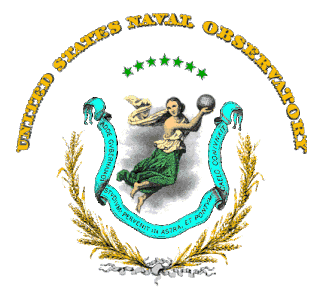
The United States Naval Observatory (USNO) is one of the oldest scientific agencies in the United States, with a primary mission to produce Positioning, Navigation and Timing (PNT) for the United States Navy and the United States Department of Defense. Located in Northwest Washington, D.C. at the Northwestern end of Embassy Row, it is one of the pre-1900 astronomical observatories located in an urban area; at the time of its construction, it was far from the light pollution thrown off by the (then-smaller) city center. Former USNO director Gernot M. R. Winkler initiated the "Master Clock" service that the USNO still operates, and which provides precise time to the GPS satellite constellation run by the United States Space Force. The USNO performs radio VLBI-based positions of quasars with numerous global collaborators, in order to produce Earth Orientation parameters.

Bad Doberan is a former district in Mecklenburg-Vorpommern, Germany. It was named after its largest town, Bad Doberan, the German Bad meaning spa. The district surrounded the City of Rostock, bordering the Baltic Sea in the north as well as the former districts of Nordvorpommern, Güstrow and Nordwestmecklenburg. The district was disbanded at the district reform of September 2011. Its territory has been part of the district of Rostock since.
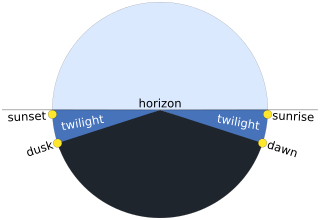
Twilight on Earth is the illumination of the lower atmosphere when the Sun is not directly visible because it is below the horizon. Twilight is produced by sunlight scattering in the upper atmosphere, illuminating the lower atmosphere so that Earth's surface is neither completely lit nor completely dark. The word twilight is also used to denote the periods of time when this illumination occurs.
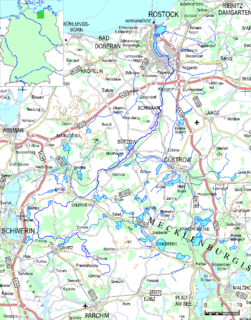
The Warnow is a river in the state of Mecklenburg-Vorpommern in Germany. It flows into the Baltic Sea near the town of Rostock, in its borough Warnemünde.

The Prague Astronomical Clock or Prague Orloj is a medieval astronomical clock attached to the Old Town Hall in Prague, the capital of the Czech Republic.
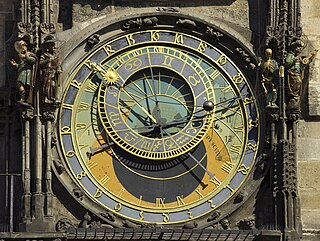
An astronomical clock, horologium, or orloj is a clock with special mechanisms and dials to display astronomical information, such as the relative positions of the sun, moon, zodiacal constellations, and sometimes major planets.

The Ostseestadion is the home stadium of FC Hansa Rostock, a German association football club, located in the city of Rostock. It has a capacity of 29,000.
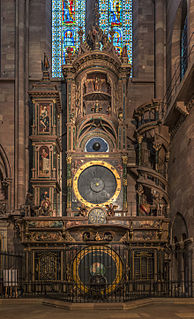
The Strasbourg astronomical clock is located in the Cathédrale Notre-Dame of Strasbourg, Alsace, France. It is the third clock on that spot and dates from the time of the first French possession of the city (1681–1870). The first clock had been built in the 14th century, the second in the 16th century, when Strasbourg was a Free imperial city of the Holy Roman Empire.
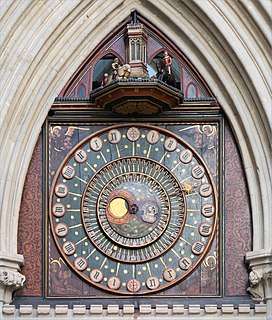
The Wells Cathedral clock is an astronomical clock in the north transept of Wells Cathedral, England. The clock is one of the group of famous 14th to 16th century astronomical clocks to be found in the West of England. The surviving mechanism, dated to between 1386 and 1392, was replaced in the 19th century, and was eventually moved to the Science Museum in London, where it continues to operate. The dial represents the geocentric view of the universe, with sun and moon revolving round a central fixed earth. It may be unique in showing a philosophical model of the pre-Copernican universe.

St. Mary's Church, Rostock, in German Marienkirche, is the biggest of three town churches found in the Hanseatic city of Rostock, in northern Germany. The other two are St. Peter's (Petrikirche) and St. Nicholas (Nikolaikirche). A fourth, St. James' (Jakobikirche), was heavily damaged during the Second World War and subsequently demolished. St. Mary's was designated in 1265 as the main parish church. Since the Protestant Reformation in 1531, it houses a congregation of the Evangelical Lutheran State Church of Mecklenburg.
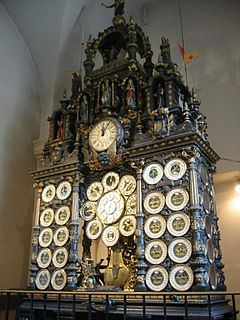
The Besançon astronomical clock is housed in Besançon Cathedral. Auguste-Lucien Vérité fr:Auguste-Lucien Vérité of Beauvais designed and built Besançon's present astronomical clock, between 1858 and 1863. It replaced an earlier clock that Bernardin had constructed in the 1850s that proved unsatisfactory. Besançon's clock differs from those in Strasbourg, Lyon, and Beauvais. The clock is meant to express the theological concept that each second of the day the Resurrection of Christ transforms the existence of man and of the world.
Hans Düringer was a clockmaker from Nuremberg in Germany who died 1477 in Rostock. His most famous works are

Warnemünde Church is a neogothic building in Warnemünde, which is a part of the hanseatic city of Rostock. Construction of the current brick building began in 1866 and the church was consecrated in 1871. The church of Warnemünde stands for over one hundred years in the middle of the town and is the center of the Evangelical Lutheran congregation. For the community along with many guests it is a place of rest and prayer. But it has also even given protection from flooding. The maritime atmosphere is shown by the special votive ships inside.

Rostock Heath is a wood and heathland region northeast of the German city of Rostock. It has a total area of about 6000 hectares and, since 1252, has been owned by the Hanseatic city of Rostock. As a result of its ownership of the Rostock Heath, Rostock is today one of the five largest communal woodland owners in Germany.

Hampton Court astronomical clock is a sixteenth-century astronomical clock in Hampton Court Palace.

The Gdańsk astronomical clock is a fifteenth-century astronomical clock in St. Mary's Church, Gdańsk.

The Beauvais Astronomical Clock is a nineteenth-century astronomical clock in Beauvais Cathedral in northern France.

The astronomical clock of Messina is an astronomical clock constructed by the Ungerer Company of Strasbourg in 1933. It is built into the campanile of Messina Cathedral.

Nikolaus Lilienfeld was a German engineer and clockmaker of the late 14th and early 15th centuries.
Manfred Schukowski is a German academic teacher and author of works on astronomical clocks.